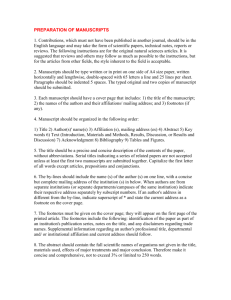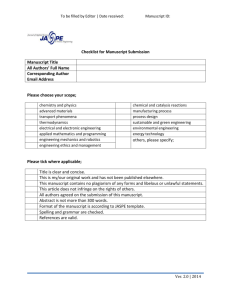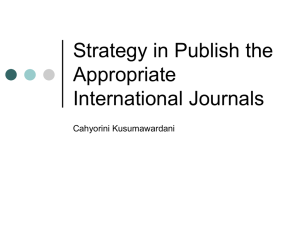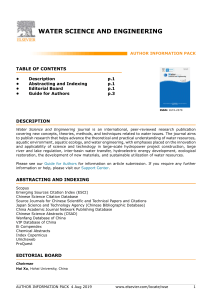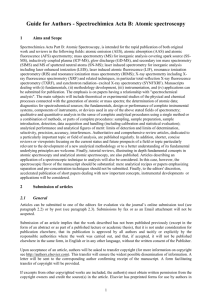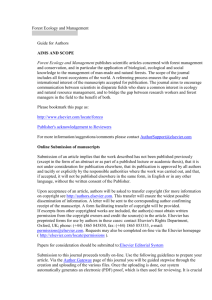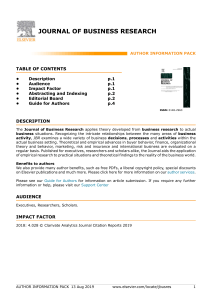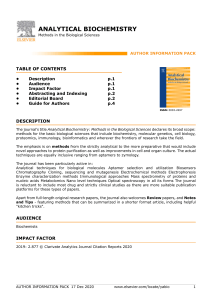CATALYSIS TODAY - MRS-S
advertisement
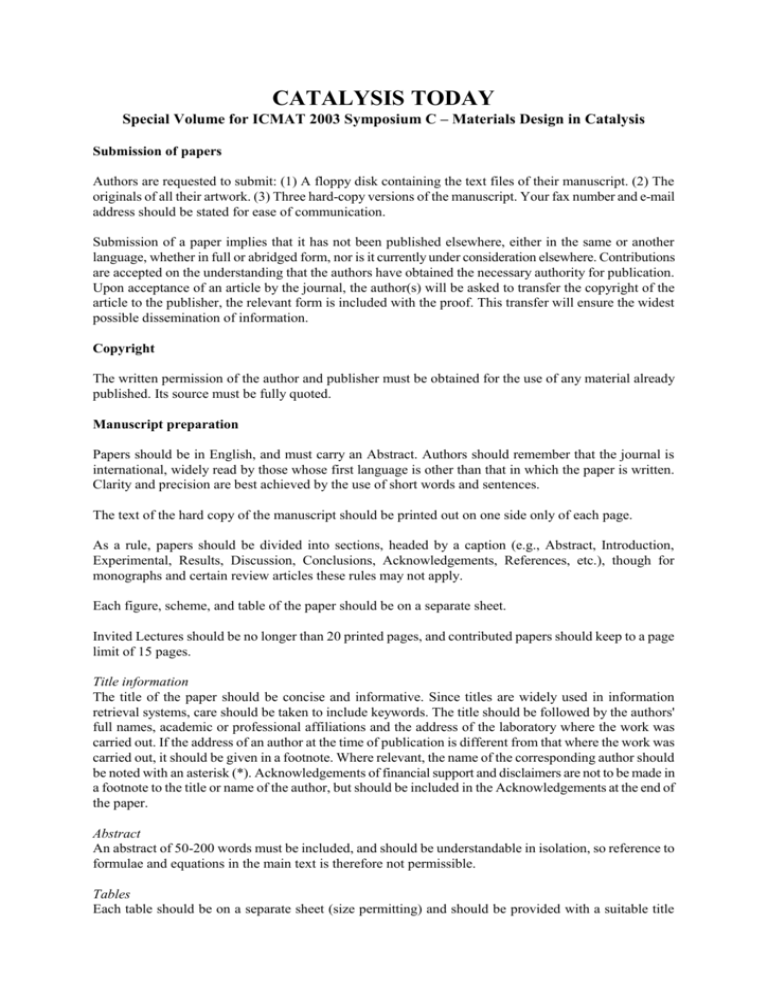
CATALYSIS TODAY Special Volume for ICMAT 2003 Symposium C – Materials Design in Catalysis Submission of papers Authors are requested to submit: (1) A floppy disk containing the text files of their manuscript. (2) The originals of all their artwork. (3) Three hard-copy versions of the manuscript. Your fax number and e-mail address should be stated for ease of communication. Submission of a paper implies that it has not been published elsewhere, either in the same or another language, whether in full or abridged form, nor is it currently under consideration elsewhere. Contributions are accepted on the understanding that the authors have obtained the necessary authority for publication. Upon acceptance of an article by the journal, the author(s) will be asked to transfer the copyright of the article to the publisher, the relevant form is included with the proof. This transfer will ensure the widest possible dissemination of information. Copyright The written permission of the author and publisher must be obtained for the use of any material already published. Its source must be fully quoted. Manuscript preparation Papers should be in English, and must carry an Abstract. Authors should remember that the journal is international, widely read by those whose first language is other than that in which the paper is written. Clarity and precision are best achieved by the use of short words and sentences. The text of the hard copy of the manuscript should be printed out on one side only of each page. As a rule, papers should be divided into sections, headed by a caption (e.g., Abstract, Introduction, Experimental, Results, Discussion, Conclusions, Acknowledgements, References, etc.), though for monographs and certain review articles these rules may not apply. Each figure, scheme, and table of the paper should be on a separate sheet. Invited Lectures should be no longer than 20 printed pages, and contributed papers should keep to a page limit of 15 pages. Title information The title of the paper should be concise and informative. Since titles are widely used in information retrieval systems, care should be taken to include keywords. The title should be followed by the authors' full names, academic or professional affiliations and the address of the laboratory where the work was carried out. If the address of an author at the time of publication is different from that where the work was carried out, it should be given in a footnote. Where relevant, the name of the corresponding author should be noted with an asterisk (*). Acknowledgements of financial support and disclaimers are not to be made in a footnote to the title or name of the author, but should be included in the Acknowledgements at the end of the paper. Abstract An abstract of 50-200 words must be included, and should be understandable in isolation, so reference to formulae and equations in the main text is therefore not permissible. Tables Each table should be on a separate sheet (size permitting) and should be provided with a suitable title which makes the general meaning understandable without reference to the text. They should, moreover, be clearly referred to in the text using Arabic numerals. Considerable thought should be given to their layout so that the information they contain can be readily and quickly grasped by the reader. Nomenclature, symbols and abbreviations Only widely accepted symbols and forms of abbreviation should be used. If there is any doubt about a particular symbol or abbreviation, the full expression followed by the abbreviation should be given the first time it appears in the text. Abbreviations used in tables and figures should be explained in the legends. In general, the recommendations of the International Union of Pure and Applied Chemistry (IUPAC) should be followed, and SI units should be used or SI equivalents of other units used should be given. Computer print-outs of data received by recording instruments will not in general be published but an indication may be given in the article where the auxiliary data are available. References The references should be brought together at the end of the article or chapter, and numbered in the order of their appearance in the text. Footnotes should not include bibliographic material. Authors should ensure that every reference in the text appears in the list of references. Numerals for the references in the text are given in square brackets [ ]. In addition, since papers are also stored in information retrieval systems each reference should be separately numerically numbered, without the use of alphabetical suffixes. In the text the authors' names are given without initials. When reference is made to a publication written by more than two authors, it is preferable to give only the first author's name in the text followed by `et al.'. In the list of references the names and initials of all authors must be given. In the reference list, periodicals [1], monographs [2], multi-author books [3], proceedings [4] and the Studies in Surface Science and Catalysis series [5] should be cited in accordance with the following examples: [1] M.V. Twigg and J.T. Richardson, Appl. Catal. A, 190 (2000) 61-72. [2] R. Mezaki, M. Mochizuki and K. Ogawa, Engineering Data on Mixing, Elsevier, Amsterdam, 2000, p. 117. [3] S. Vasileiadis and Z. Ziaka, in M.A. Abraham and R.P. Hesketh (eds.), Reaction Engineering for Pollution Prevention, Elsevier, Amsterdam, 2000, pp. 247-304. [4] G.C. Bond and P.B. Wells, Proc. 4th Int. Symp. Scientific Bases for the Preparation of Heterogeneous Catalysts, Louvain-la-Neuve, 1-4 Sept. 1986, paper No. 2. [5] K.K. Unger, G. Kreysa and J.P. Baselt (eds.), Studies in Surface Science and Catalysis, 128 (2000) 110. Abbreviations for the titles of journals should follow the system used by Chemical Abstracts Service Source Index, and supplements. Articles not yet published should be indicated in the reference list as `in press', `submitted' or `in preparation'. When `in press' or `submitted' the journal title should be given. Results not yet published should be indicated as `unpublished results' or `personal communication', preceded by the name of the person supplying the information, and preferably also giving the year. Illustrations The figures, schemes and formulae should be clearly labelled and submitted in a form suitable for reproduction, drawn, plotted or printed in black ink on white or tracing paper on sheets separate from the main text. Axes of a graph should be clearly labelled. Please note that any lettering should also be in a form suitable for reproduction. Lettering (which should be kept to a minimum) and spacing on axes of graphs should be sufficiently large in relation to the size of the figure to remain legible after reduction (75-50%). One original and one photocopy of each figure or scheme are required. The figures should preferably be of such a size that the same degree of reduction can be applied to all of them. Standard symbols should be used in line drawings. Photographs, autoradiographs and electronmicrographs should have good contrast. Sharp, glossy photographs are required to obtain good half-tones. A scale bar with appropriate value and units is the best indication of the size of the features in micrographs. Please include electronic files of the images when possible. Reference to each illustration should be included in appropriate places in the text using Arabic numerals. Each illustration should have a caption. All the captions (to figures and/or schemes) should be given on a separate sheet and be understandable without reference to the main text. If structures are given in the text, original drawings should be provided. Coloured illustrations are reproduced at the author's expense. The cost is determined by the number of pages and by the number of colours needed. Electronic manuscripts The preferred storage medium is a 3 1/2 inch disk in MS-DOS or MS-DOS compatible format, though other systems are welcome. Procedure after acceptance Proofs One set of proofs will be sent to the author for checking. Since there is also an electronic version of the manuscript, there will be a minimum to negligible number of errors introduced during the production of the proofs. Corrections must therefore be restricted to printer's errors. No changes in, or additions to, the edited manuscript will be accepted. A copyright transfer form and an offprint order form are included with the proof. These should be completed and returned with the proof. If you need any further information contact: Stephan Jaenicke Department of Chemistry National University of Singapore Kent Ridge Singapore 117543 Republic of Singapore chmsj@nus.edu.sg FAX: (65) 6779 1691 Laura Hassink Elsevier Science B.V. Chemistry Section P.O. Box 330 1000 AH Amsterdam Netherlands l.hassink@elsevier.com Fax. (+31-20) 485 2845


